Going live and ERP journey
VerifiedAdded on 2022/11/17
|15
|4348
|377
AI Summary
This article discusses the journey of implementing ERP software, including defining implementation scopes and objectives, selecting ERP systems, creating project plans, defining implementation phases, making an achievable schedule, planning testing, migrating business data, preparing for changes, planning the go-live, supporting and maintenance. It also identifies barriers and drivers for companies in moving from one stage to another.
Contribute Materials
Your contribution can guide someone’s learning journey. Share your
documents today.
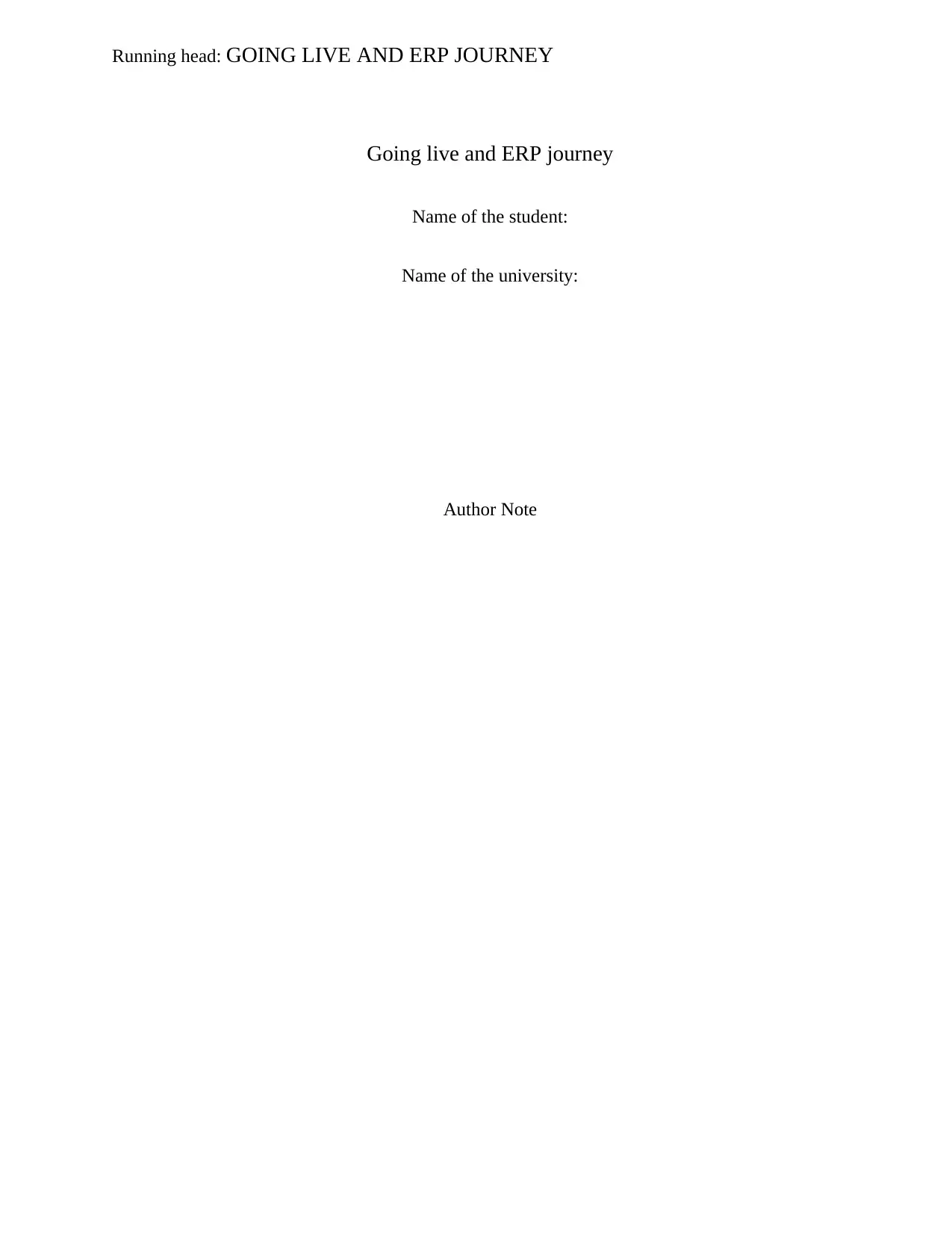
Running head: GOING LIVE AND ERP JOURNEY
Going live and ERP journey
Name of the student:
Name of the university:
Author Note
Going live and ERP journey
Name of the student:
Name of the university:
Author Note
Secure Best Marks with AI Grader
Need help grading? Try our AI Grader for instant feedback on your assignments.
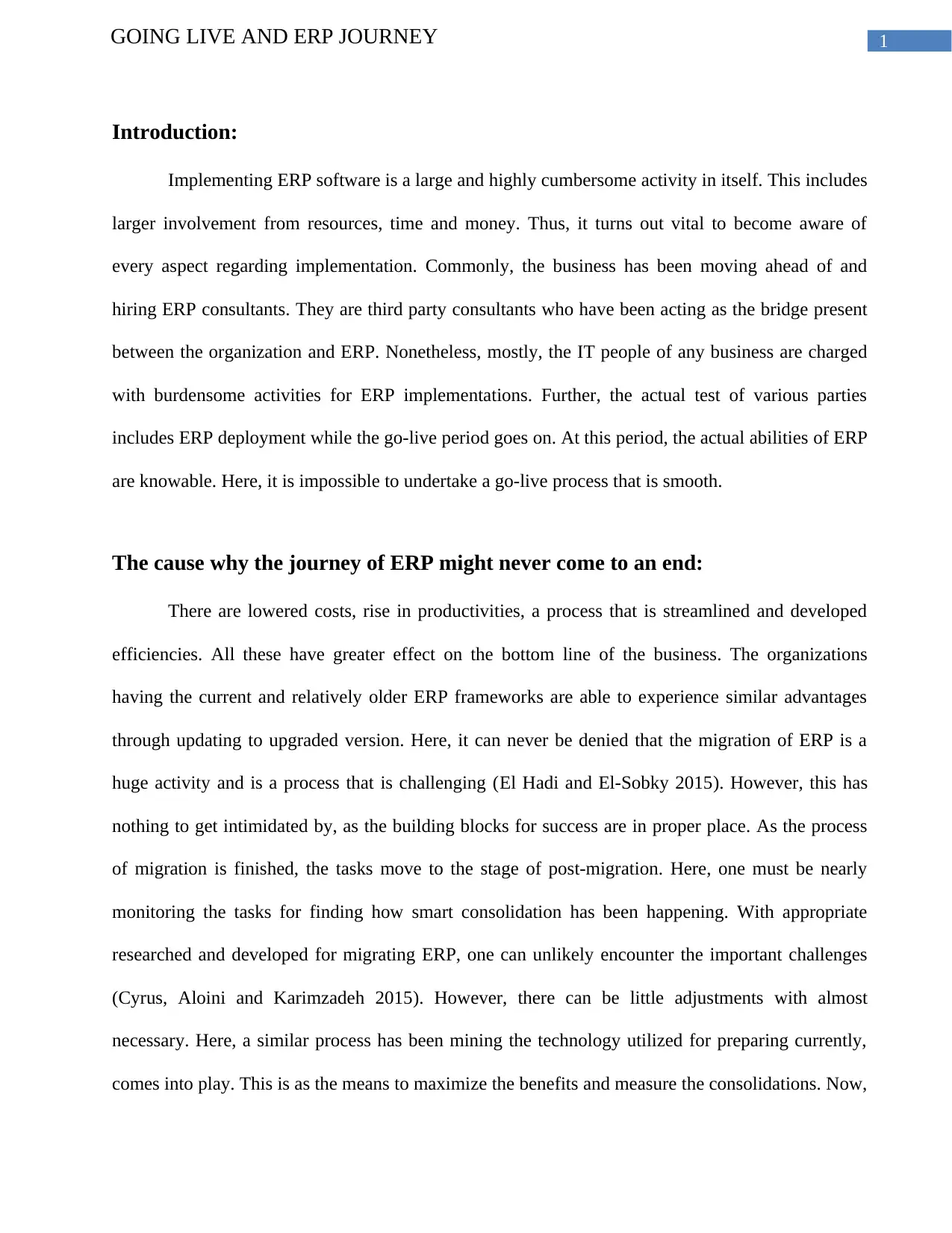
1GOING LIVE AND ERP JOURNEY
Introduction:
Implementing ERP software is a large and highly cumbersome activity in itself. This includes
larger involvement from resources, time and money. Thus, it turns out vital to become aware of
every aspect regarding implementation. Commonly, the business has been moving ahead of and
hiring ERP consultants. They are third party consultants who have been acting as the bridge present
between the organization and ERP. Nonetheless, mostly, the IT people of any business are charged
with burdensome activities for ERP implementations. Further, the actual test of various parties
includes ERP deployment while the go-live period goes on. At this period, the actual abilities of ERP
are knowable. Here, it is impossible to undertake a go-live process that is smooth.
The cause why the journey of ERP might never come to an end:
There are lowered costs, rise in productivities, a process that is streamlined and developed
efficiencies. All these have greater effect on the bottom line of the business. The organizations
having the current and relatively older ERP frameworks are able to experience similar advantages
through updating to upgraded version. Here, it can never be denied that the migration of ERP is a
huge activity and is a process that is challenging (El Hadi and El-Sobky 2015). However, this has
nothing to get intimidated by, as the building blocks for success are in proper place. As the process
of migration is finished, the tasks move to the stage of post-migration. Here, one must be nearly
monitoring the tasks for finding how smart consolidation has been happening. With appropriate
researched and developed for migrating ERP, one can unlikely encounter the important challenges
(Cyrus, Aloini and Karimzadeh 2015). However, there can be little adjustments with almost
necessary. Here, a similar process has been mining the technology utilized for preparing currently,
comes into play. This is as the means to maximize the benefits and measure the consolidations. Now,
Introduction:
Implementing ERP software is a large and highly cumbersome activity in itself. This includes
larger involvement from resources, time and money. Thus, it turns out vital to become aware of
every aspect regarding implementation. Commonly, the business has been moving ahead of and
hiring ERP consultants. They are third party consultants who have been acting as the bridge present
between the organization and ERP. Nonetheless, mostly, the IT people of any business are charged
with burdensome activities for ERP implementations. Further, the actual test of various parties
includes ERP deployment while the go-live period goes on. At this period, the actual abilities of ERP
are knowable. Here, it is impossible to undertake a go-live process that is smooth.
The cause why the journey of ERP might never come to an end:
There are lowered costs, rise in productivities, a process that is streamlined and developed
efficiencies. All these have greater effect on the bottom line of the business. The organizations
having the current and relatively older ERP frameworks are able to experience similar advantages
through updating to upgraded version. Here, it can never be denied that the migration of ERP is a
huge activity and is a process that is challenging (El Hadi and El-Sobky 2015). However, this has
nothing to get intimidated by, as the building blocks for success are in proper place. As the process
of migration is finished, the tasks move to the stage of post-migration. Here, one must be nearly
monitoring the tasks for finding how smart consolidation has been happening. With appropriate
researched and developed for migrating ERP, one can unlikely encounter the important challenges
(Cyrus, Aloini and Karimzadeh 2015). However, there can be little adjustments with almost
necessary. Here, a similar process has been mining the technology utilized for preparing currently,
comes into play. This is as the means to maximize the benefits and measure the consolidations. Now,
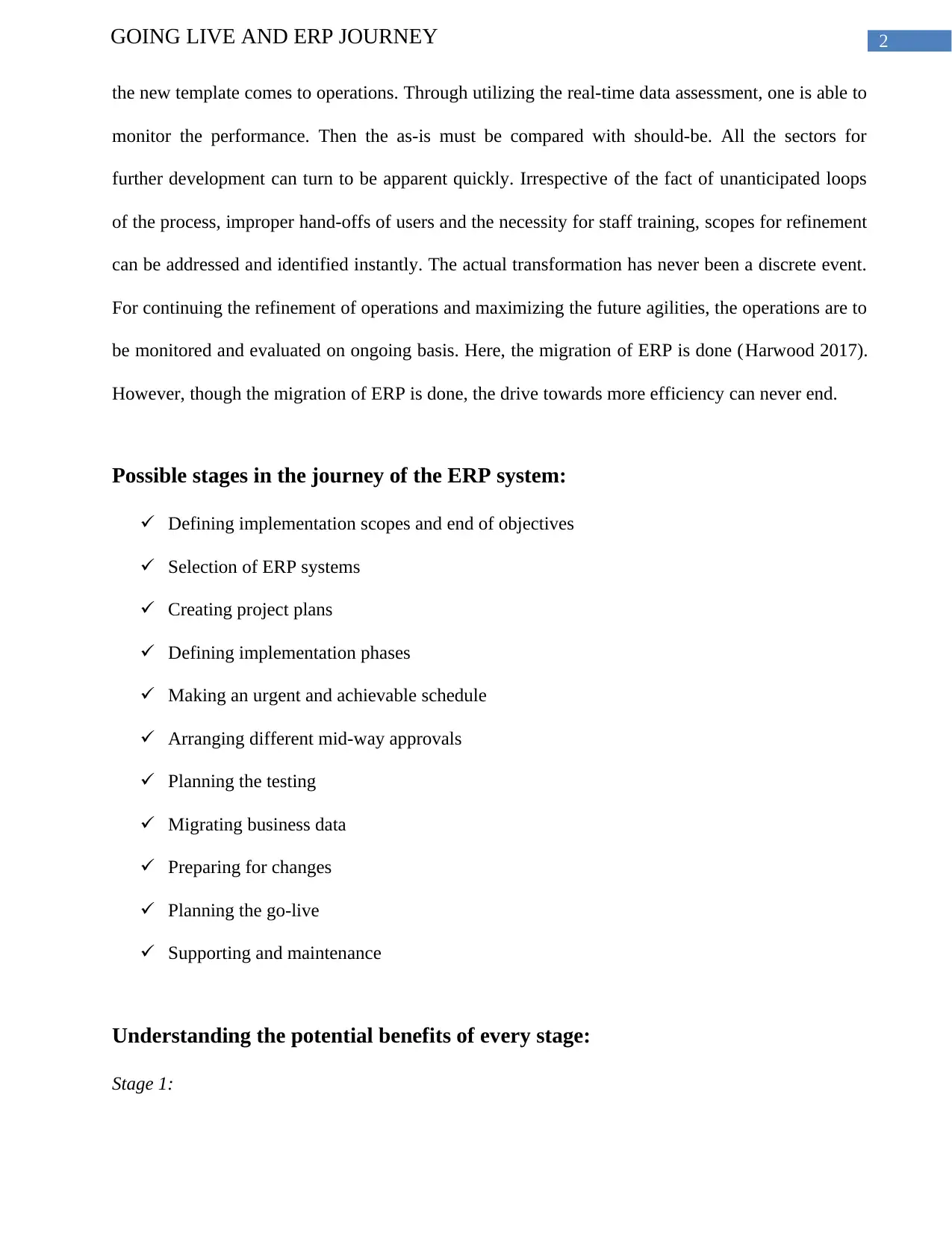
2GOING LIVE AND ERP JOURNEY
the new template comes to operations. Through utilizing the real-time data assessment, one is able to
monitor the performance. Then the as-is must be compared with should-be. All the sectors for
further development can turn to be apparent quickly. Irrespective of the fact of unanticipated loops
of the process, improper hand-offs of users and the necessity for staff training, scopes for refinement
can be addressed and identified instantly. The actual transformation has never been a discrete event.
For continuing the refinement of operations and maximizing the future agilities, the operations are to
be monitored and evaluated on ongoing basis. Here, the migration of ERP is done (Harwood 2017).
However, though the migration of ERP is done, the drive towards more efficiency can never end.
Possible stages in the journey of the ERP system:
Defining implementation scopes and end of objectives
Selection of ERP systems
Creating project plans
Defining implementation phases
Making an urgent and achievable schedule
Arranging different mid-way approvals
Planning the testing
Migrating business data
Preparing for changes
Planning the go-live
Supporting and maintenance
Understanding the potential benefits of every stage:
Stage 1:
the new template comes to operations. Through utilizing the real-time data assessment, one is able to
monitor the performance. Then the as-is must be compared with should-be. All the sectors for
further development can turn to be apparent quickly. Irrespective of the fact of unanticipated loops
of the process, improper hand-offs of users and the necessity for staff training, scopes for refinement
can be addressed and identified instantly. The actual transformation has never been a discrete event.
For continuing the refinement of operations and maximizing the future agilities, the operations are to
be monitored and evaluated on ongoing basis. Here, the migration of ERP is done (Harwood 2017).
However, though the migration of ERP is done, the drive towards more efficiency can never end.
Possible stages in the journey of the ERP system:
Defining implementation scopes and end of objectives
Selection of ERP systems
Creating project plans
Defining implementation phases
Making an urgent and achievable schedule
Arranging different mid-way approvals
Planning the testing
Migrating business data
Preparing for changes
Planning the go-live
Supporting and maintenance
Understanding the potential benefits of every stage:
Stage 1:
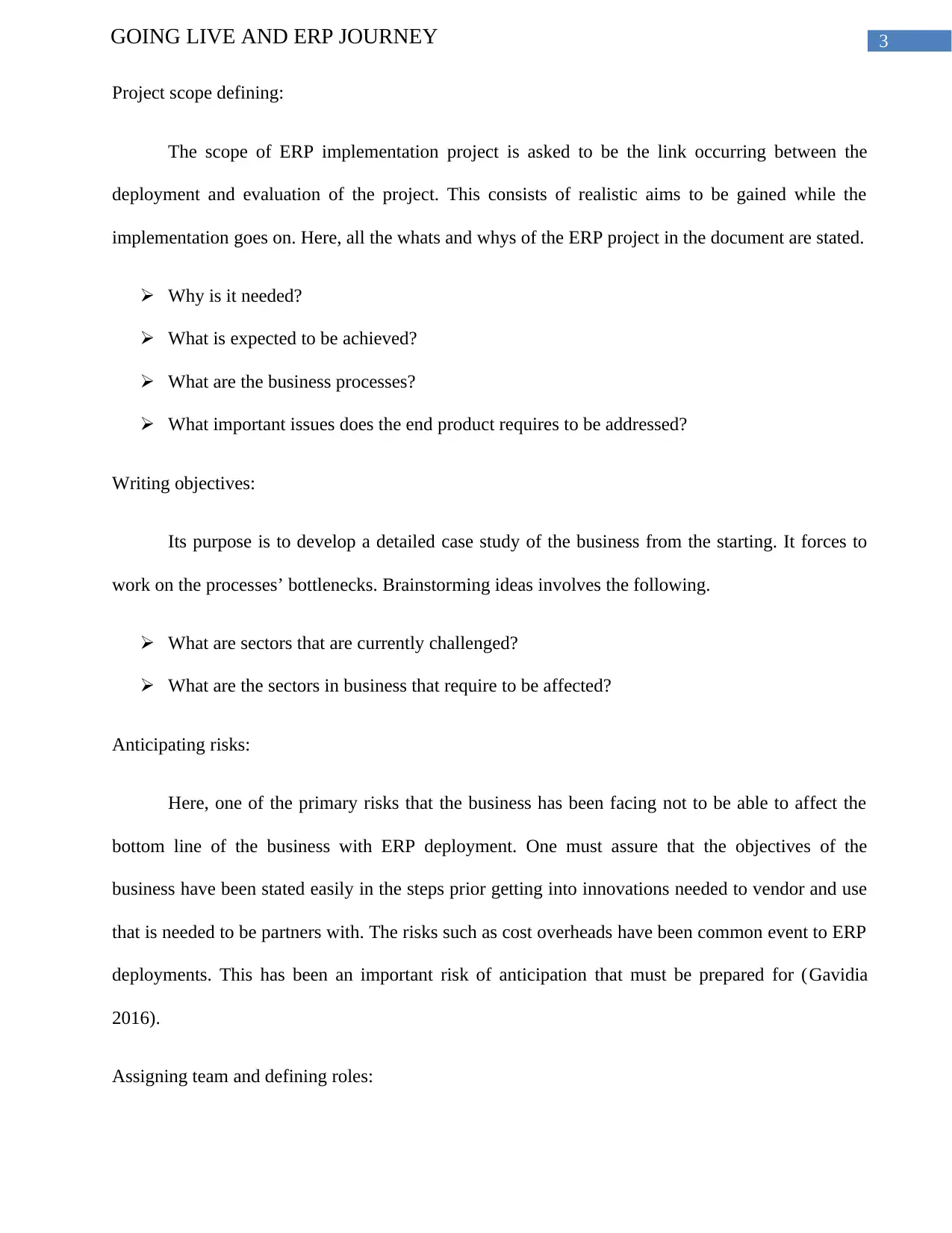
3GOING LIVE AND ERP JOURNEY
Project scope defining:
The scope of ERP implementation project is asked to be the link occurring between the
deployment and evaluation of the project. This consists of realistic aims to be gained while the
implementation goes on. Here, all the whats and whys of the ERP project in the document are stated.
Why is it needed?
What is expected to be achieved?
What are the business processes?
What important issues does the end product requires to be addressed?
Writing objectives:
Its purpose is to develop a detailed case study of the business from the starting. It forces to
work on the processes’ bottlenecks. Brainstorming ideas involves the following.
What are sectors that are currently challenged?
What are the sectors in business that require to be affected?
Anticipating risks:
Here, one of the primary risks that the business has been facing not to be able to affect the
bottom line of the business with ERP deployment. One must assure that the objectives of the
business have been stated easily in the steps prior getting into innovations needed to vendor and use
that is needed to be partners with. The risks such as cost overheads have been common event to ERP
deployments. This has been an important risk of anticipation that must be prepared for (Gavidia
2016).
Assigning team and defining roles:
Project scope defining:
The scope of ERP implementation project is asked to be the link occurring between the
deployment and evaluation of the project. This consists of realistic aims to be gained while the
implementation goes on. Here, all the whats and whys of the ERP project in the document are stated.
Why is it needed?
What is expected to be achieved?
What are the business processes?
What important issues does the end product requires to be addressed?
Writing objectives:
Its purpose is to develop a detailed case study of the business from the starting. It forces to
work on the processes’ bottlenecks. Brainstorming ideas involves the following.
What are sectors that are currently challenged?
What are the sectors in business that require to be affected?
Anticipating risks:
Here, one of the primary risks that the business has been facing not to be able to affect the
bottom line of the business with ERP deployment. One must assure that the objectives of the
business have been stated easily in the steps prior getting into innovations needed to vendor and use
that is needed to be partners with. The risks such as cost overheads have been common event to ERP
deployments. This has been an important risk of anticipation that must be prepared for (Gavidia
2016).
Assigning team and defining roles:
Secure Best Marks with AI Grader
Need help grading? Try our AI Grader for instant feedback on your assignments.
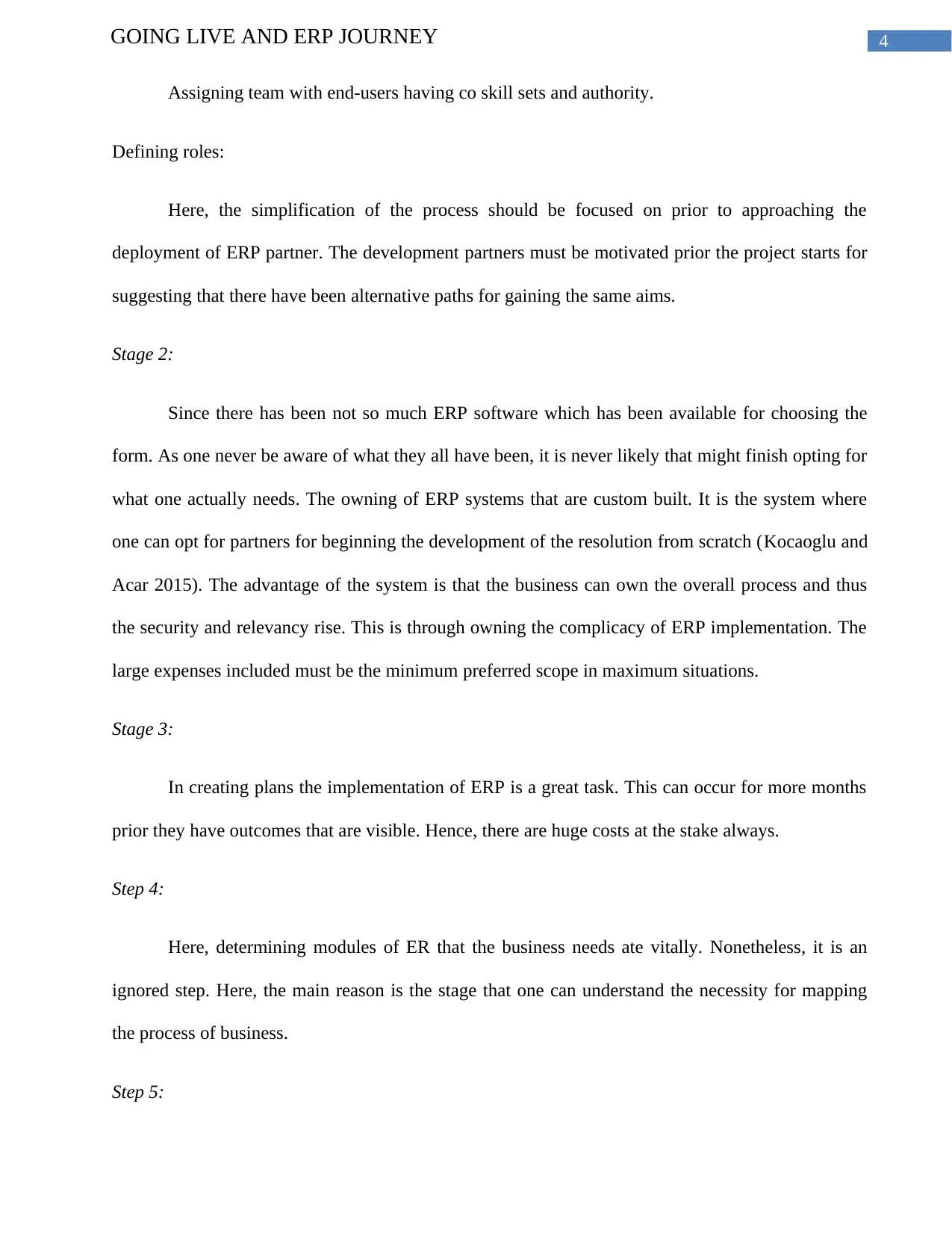
4GOING LIVE AND ERP JOURNEY
Assigning team with end-users having co skill sets and authority.
Defining roles:
Here, the simplification of the process should be focused on prior to approaching the
deployment of ERP partner. The development partners must be motivated prior the project starts for
suggesting that there have been alternative paths for gaining the same aims.
Stage 2:
Since there has been not so much ERP software which has been available for choosing the
form. As one never be aware of what they all have been, it is never likely that might finish opting for
what one actually needs. The owning of ERP systems that are custom built. It is the system where
one can opt for partners for beginning the development of the resolution from scratch (Kocaoglu and
Acar 2015). The advantage of the system is that the business can own the overall process and thus
the security and relevancy rise. This is through owning the complicacy of ERP implementation. The
large expenses included must be the minimum preferred scope in maximum situations.
Stage 3:
In creating plans the implementation of ERP is a great task. This can occur for more months
prior they have outcomes that are visible. Hence, there are huge costs at the stake always.
Step 4:
Here, determining modules of ER that the business needs ate vitally. Nonetheless, it is an
ignored step. Here, the main reason is the stage that one can understand the necessity for mapping
the process of business.
Step 5:
Assigning team with end-users having co skill sets and authority.
Defining roles:
Here, the simplification of the process should be focused on prior to approaching the
deployment of ERP partner. The development partners must be motivated prior the project starts for
suggesting that there have been alternative paths for gaining the same aims.
Stage 2:
Since there has been not so much ERP software which has been available for choosing the
form. As one never be aware of what they all have been, it is never likely that might finish opting for
what one actually needs. The owning of ERP systems that are custom built. It is the system where
one can opt for partners for beginning the development of the resolution from scratch (Kocaoglu and
Acar 2015). The advantage of the system is that the business can own the overall process and thus
the security and relevancy rise. This is through owning the complicacy of ERP implementation. The
large expenses included must be the minimum preferred scope in maximum situations.
Stage 3:
In creating plans the implementation of ERP is a great task. This can occur for more months
prior they have outcomes that are visible. Hence, there are huge costs at the stake always.
Step 4:
Here, determining modules of ER that the business needs ate vitally. Nonetheless, it is an
ignored step. Here, the main reason is the stage that one can understand the necessity for mapping
the process of business.
Step 5:
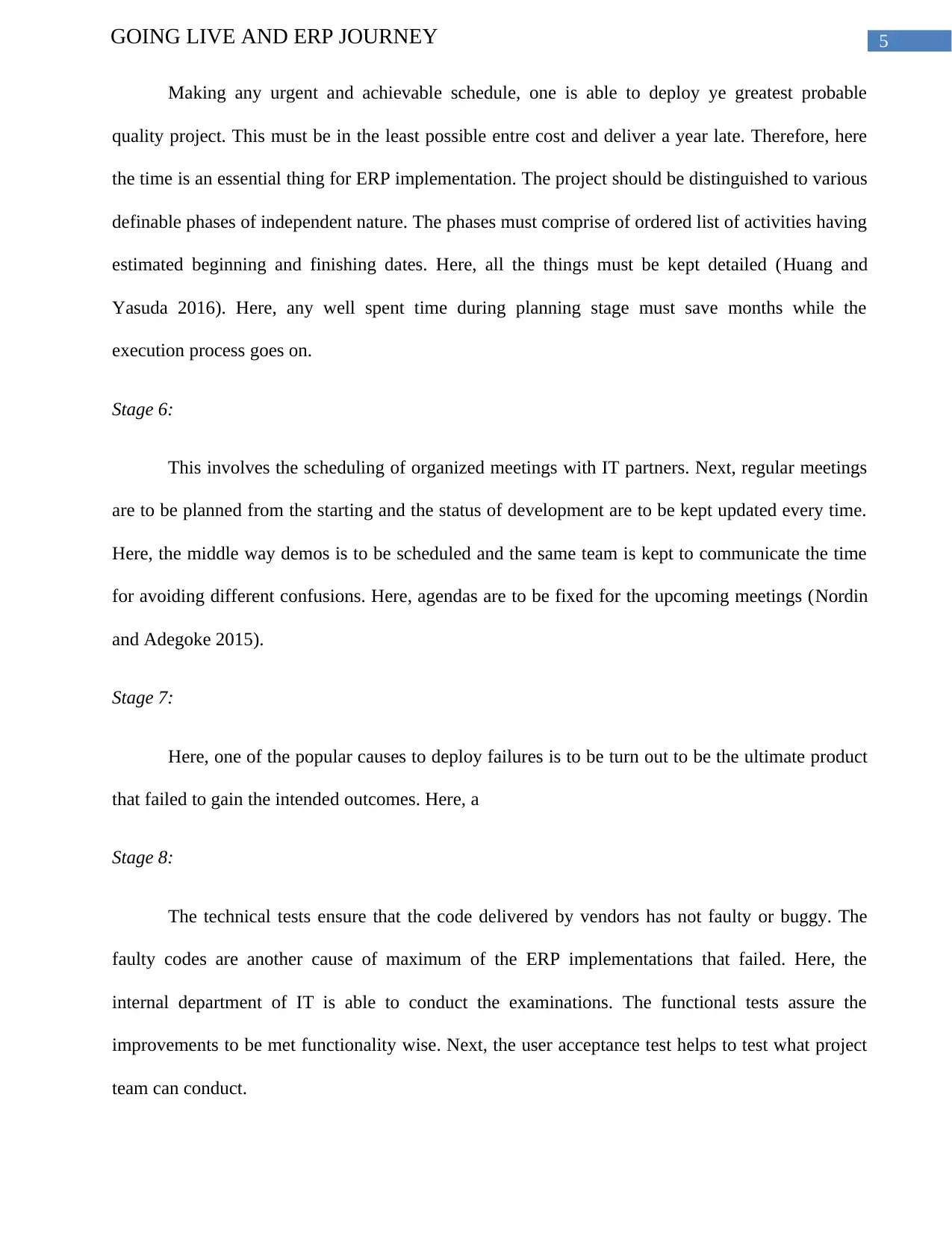
5GOING LIVE AND ERP JOURNEY
Making any urgent and achievable schedule, one is able to deploy ye greatest probable
quality project. This must be in the least possible entre cost and deliver a year late. Therefore, here
the time is an essential thing for ERP implementation. The project should be distinguished to various
definable phases of independent nature. The phases must comprise of ordered list of activities having
estimated beginning and finishing dates. Here, all the things must be kept detailed (Huang and
Yasuda 2016). Here, any well spent time during planning stage must save months while the
execution process goes on.
Stage 6:
This involves the scheduling of organized meetings with IT partners. Next, regular meetings
are to be planned from the starting and the status of development are to be kept updated every time.
Here, the middle way demos is to be scheduled and the same team is kept to communicate the time
for avoiding different confusions. Here, agendas are to be fixed for the upcoming meetings (Nordin
and Adegoke 2015).
Stage 7:
Here, one of the popular causes to deploy failures is to be turn out to be the ultimate product
that failed to gain the intended outcomes. Here, a
Stage 8:
The technical tests ensure that the code delivered by vendors has not faulty or buggy. The
faulty codes are another cause of maximum of the ERP implementations that failed. Here, the
internal department of IT is able to conduct the examinations. The functional tests assure the
improvements to be met functionality wise. Next, the user acceptance test helps to test what project
team can conduct.
Making any urgent and achievable schedule, one is able to deploy ye greatest probable
quality project. This must be in the least possible entre cost and deliver a year late. Therefore, here
the time is an essential thing for ERP implementation. The project should be distinguished to various
definable phases of independent nature. The phases must comprise of ordered list of activities having
estimated beginning and finishing dates. Here, all the things must be kept detailed (Huang and
Yasuda 2016). Here, any well spent time during planning stage must save months while the
execution process goes on.
Stage 6:
This involves the scheduling of organized meetings with IT partners. Next, regular meetings
are to be planned from the starting and the status of development are to be kept updated every time.
Here, the middle way demos is to be scheduled and the same team is kept to communicate the time
for avoiding different confusions. Here, agendas are to be fixed for the upcoming meetings (Nordin
and Adegoke 2015).
Stage 7:
Here, one of the popular causes to deploy failures is to be turn out to be the ultimate product
that failed to gain the intended outcomes. Here, a
Stage 8:
The technical tests ensure that the code delivered by vendors has not faulty or buggy. The
faulty codes are another cause of maximum of the ERP implementations that failed. Here, the
internal department of IT is able to conduct the examinations. The functional tests assure the
improvements to be met functionality wise. Next, the user acceptance test helps to test what project
team can conduct.
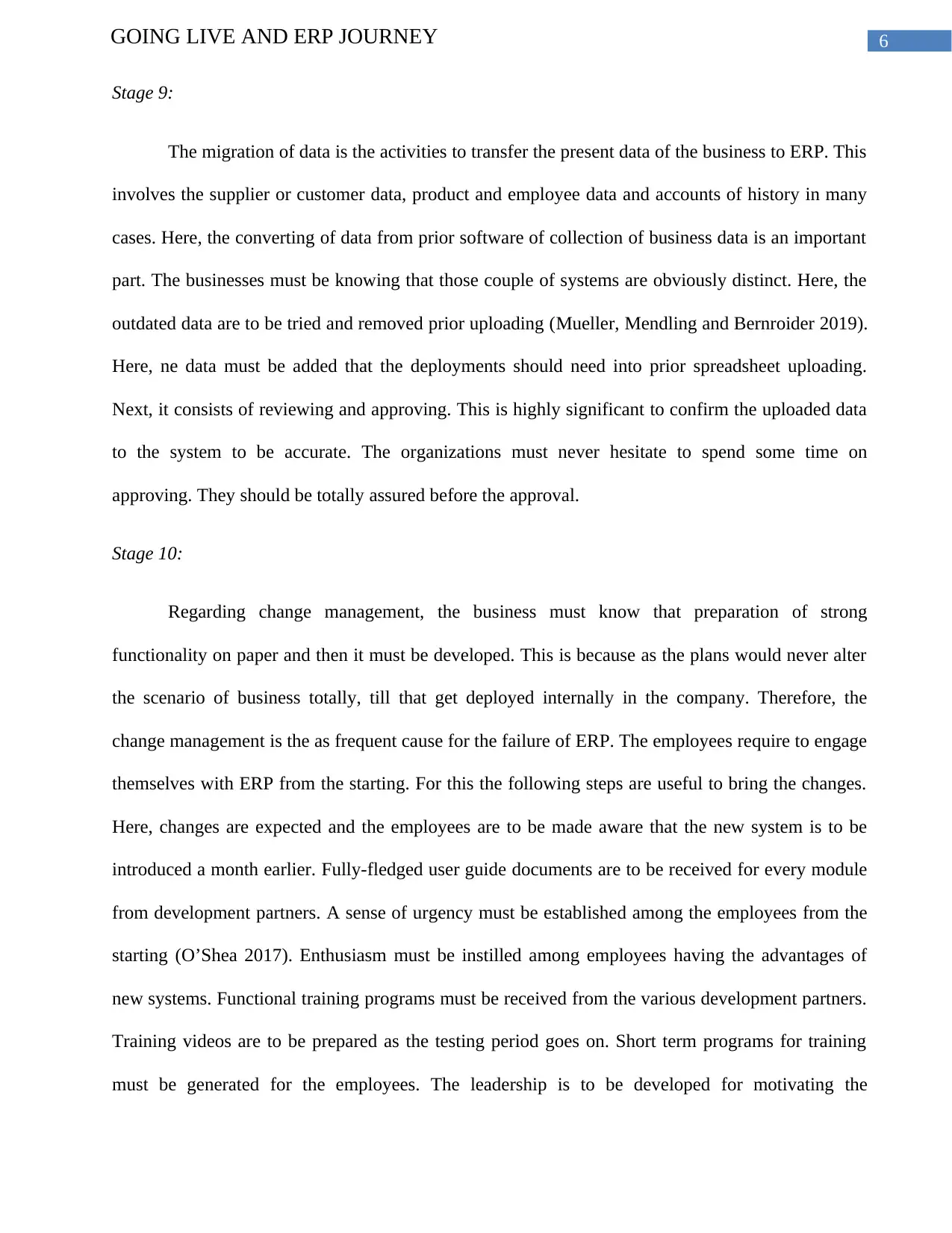
6GOING LIVE AND ERP JOURNEY
Stage 9:
The migration of data is the activities to transfer the present data of the business to ERP. This
involves the supplier or customer data, product and employee data and accounts of history in many
cases. Here, the converting of data from prior software of collection of business data is an important
part. The businesses must be knowing that those couple of systems are obviously distinct. Here, the
outdated data are to be tried and removed prior uploading (Mueller, Mendling and Bernroider 2019).
Here, ne data must be added that the deployments should need into prior spreadsheet uploading.
Next, it consists of reviewing and approving. This is highly significant to confirm the uploaded data
to the system to be accurate. The organizations must never hesitate to spend some time on
approving. They should be totally assured before the approval.
Stage 10:
Regarding change management, the business must know that preparation of strong
functionality on paper and then it must be developed. This is because as the plans would never alter
the scenario of business totally, till that get deployed internally in the company. Therefore, the
change management is the as frequent cause for the failure of ERP. The employees require to engage
themselves with ERP from the starting. For this the following steps are useful to bring the changes.
Here, changes are expected and the employees are to be made aware that the new system is to be
introduced a month earlier. Fully-fledged user guide documents are to be received for every module
from development partners. A sense of urgency must be established among the employees from the
starting (O’Shea 2017). Enthusiasm must be instilled among employees having the advantages of
new systems. Functional training programs must be received from the various development partners.
Training videos are to be prepared as the testing period goes on. Short term programs for training
must be generated for the employees. The leadership is to be developed for motivating the
Stage 9:
The migration of data is the activities to transfer the present data of the business to ERP. This
involves the supplier or customer data, product and employee data and accounts of history in many
cases. Here, the converting of data from prior software of collection of business data is an important
part. The businesses must be knowing that those couple of systems are obviously distinct. Here, the
outdated data are to be tried and removed prior uploading (Mueller, Mendling and Bernroider 2019).
Here, ne data must be added that the deployments should need into prior spreadsheet uploading.
Next, it consists of reviewing and approving. This is highly significant to confirm the uploaded data
to the system to be accurate. The organizations must never hesitate to spend some time on
approving. They should be totally assured before the approval.
Stage 10:
Regarding change management, the business must know that preparation of strong
functionality on paper and then it must be developed. This is because as the plans would never alter
the scenario of business totally, till that get deployed internally in the company. Therefore, the
change management is the as frequent cause for the failure of ERP. The employees require to engage
themselves with ERP from the starting. For this the following steps are useful to bring the changes.
Here, changes are expected and the employees are to be made aware that the new system is to be
introduced a month earlier. Fully-fledged user guide documents are to be received for every module
from development partners. A sense of urgency must be established among the employees from the
starting (O’Shea 2017). Enthusiasm must be instilled among employees having the advantages of
new systems. Functional training programs must be received from the various development partners.
Training videos are to be prepared as the testing period goes on. Short term programs for training
must be generated for the employees. The leadership is to be developed for motivating the
Paraphrase This Document
Need a fresh take? Get an instant paraphrase of this document with our AI Paraphraser
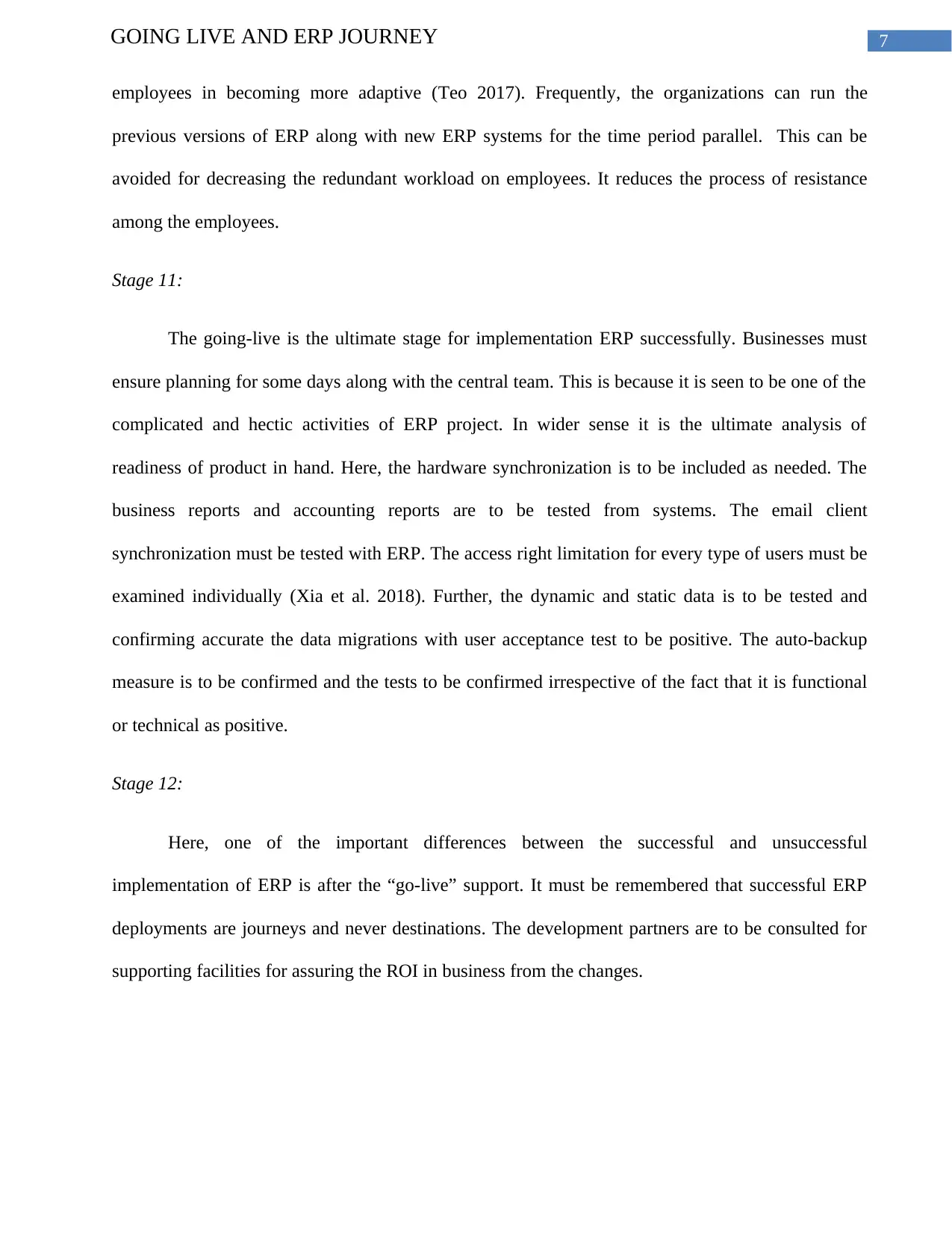
7GOING LIVE AND ERP JOURNEY
employees in becoming more adaptive (Teo 2017). Frequently, the organizations can run the
previous versions of ERP along with new ERP systems for the time period parallel. This can be
avoided for decreasing the redundant workload on employees. It reduces the process of resistance
among the employees.
Stage 11:
The going-live is the ultimate stage for implementation ERP successfully. Businesses must
ensure planning for some days along with the central team. This is because it is seen to be one of the
complicated and hectic activities of ERP project. In wider sense it is the ultimate analysis of
readiness of product in hand. Here, the hardware synchronization is to be included as needed. The
business reports and accounting reports are to be tested from systems. The email client
synchronization must be tested with ERP. The access right limitation for every type of users must be
examined individually (Xia et al. 2018). Further, the dynamic and static data is to be tested and
confirming accurate the data migrations with user acceptance test to be positive. The auto-backup
measure is to be confirmed and the tests to be confirmed irrespective of the fact that it is functional
or technical as positive.
Stage 12:
Here, one of the important differences between the successful and unsuccessful
implementation of ERP is after the “go-live” support. It must be remembered that successful ERP
deployments are journeys and never destinations. The development partners are to be consulted for
supporting facilities for assuring the ROI in business from the changes.
employees in becoming more adaptive (Teo 2017). Frequently, the organizations can run the
previous versions of ERP along with new ERP systems for the time period parallel. This can be
avoided for decreasing the redundant workload on employees. It reduces the process of resistance
among the employees.
Stage 11:
The going-live is the ultimate stage for implementation ERP successfully. Businesses must
ensure planning for some days along with the central team. This is because it is seen to be one of the
complicated and hectic activities of ERP project. In wider sense it is the ultimate analysis of
readiness of product in hand. Here, the hardware synchronization is to be included as needed. The
business reports and accounting reports are to be tested from systems. The email client
synchronization must be tested with ERP. The access right limitation for every type of users must be
examined individually (Xia et al. 2018). Further, the dynamic and static data is to be tested and
confirming accurate the data migrations with user acceptance test to be positive. The auto-backup
measure is to be confirmed and the tests to be confirmed irrespective of the fact that it is functional
or technical as positive.
Stage 12:
Here, one of the important differences between the successful and unsuccessful
implementation of ERP is after the “go-live” support. It must be remembered that successful ERP
deployments are journeys and never destinations. The development partners are to be consulted for
supporting facilities for assuring the ROI in business from the changes.
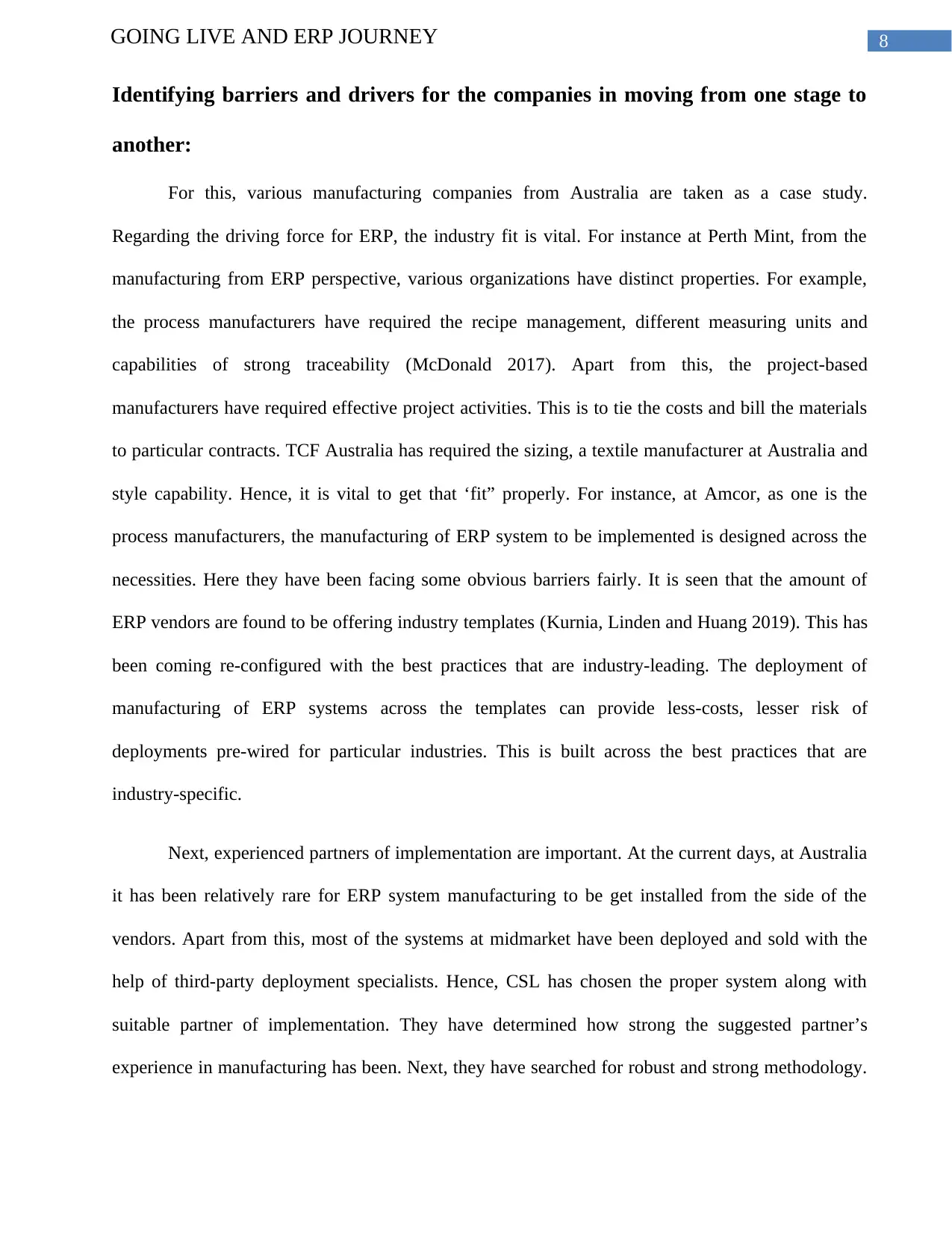
8GOING LIVE AND ERP JOURNEY
Identifying barriers and drivers for the companies in moving from one stage to
another:
For this, various manufacturing companies from Australia are taken as a case study.
Regarding the driving force for ERP, the industry fit is vital. For instance at Perth Mint, from the
manufacturing from ERP perspective, various organizations have distinct properties. For example,
the process manufacturers have required the recipe management, different measuring units and
capabilities of strong traceability (McDonald 2017). Apart from this, the project-based
manufacturers have required effective project activities. This is to tie the costs and bill the materials
to particular contracts. TCF Australia has required the sizing, a textile manufacturer at Australia and
style capability. Hence, it is vital to get that ‘fit” properly. For instance, at Amcor, as one is the
process manufacturers, the manufacturing of ERP system to be implemented is designed across the
necessities. Here they have been facing some obvious barriers fairly. It is seen that the amount of
ERP vendors are found to be offering industry templates (Kurnia, Linden and Huang 2019). This has
been coming re-configured with the best practices that are industry-leading. The deployment of
manufacturing of ERP systems across the templates can provide less-costs, lesser risk of
deployments pre-wired for particular industries. This is built across the best practices that are
industry-specific.
Next, experienced partners of implementation are important. At the current days, at Australia
it has been relatively rare for ERP system manufacturing to be get installed from the side of the
vendors. Apart from this, most of the systems at midmarket have been deployed and sold with the
help of third-party deployment specialists. Hence, CSL has chosen the proper system along with
suitable partner of implementation. They have determined how strong the suggested partner’s
experience in manufacturing has been. Next, they have searched for robust and strong methodology.
Identifying barriers and drivers for the companies in moving from one stage to
another:
For this, various manufacturing companies from Australia are taken as a case study.
Regarding the driving force for ERP, the industry fit is vital. For instance at Perth Mint, from the
manufacturing from ERP perspective, various organizations have distinct properties. For example,
the process manufacturers have required the recipe management, different measuring units and
capabilities of strong traceability (McDonald 2017). Apart from this, the project-based
manufacturers have required effective project activities. This is to tie the costs and bill the materials
to particular contracts. TCF Australia has required the sizing, a textile manufacturer at Australia and
style capability. Hence, it is vital to get that ‘fit” properly. For instance, at Amcor, as one is the
process manufacturers, the manufacturing of ERP system to be implemented is designed across the
necessities. Here they have been facing some obvious barriers fairly. It is seen that the amount of
ERP vendors are found to be offering industry templates (Kurnia, Linden and Huang 2019). This has
been coming re-configured with the best practices that are industry-leading. The deployment of
manufacturing of ERP systems across the templates can provide less-costs, lesser risk of
deployments pre-wired for particular industries. This is built across the best practices that are
industry-specific.
Next, experienced partners of implementation are important. At the current days, at Australia
it has been relatively rare for ERP system manufacturing to be get installed from the side of the
vendors. Apart from this, most of the systems at midmarket have been deployed and sold with the
help of third-party deployment specialists. Hence, CSL has chosen the proper system along with
suitable partner of implementation. They have determined how strong the suggested partner’s
experience in manufacturing has been. Next, they have searched for robust and strong methodology.
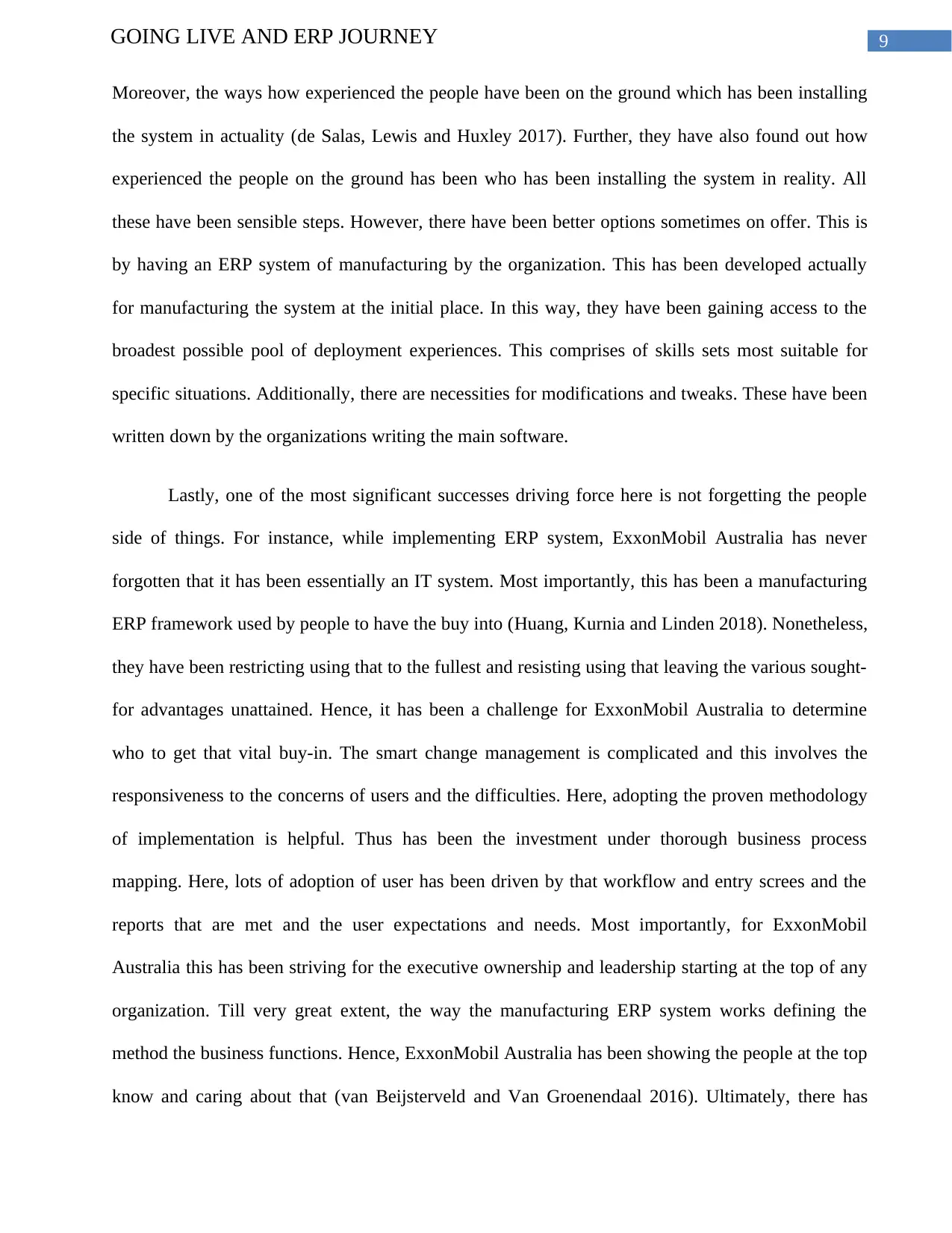
9GOING LIVE AND ERP JOURNEY
Moreover, the ways how experienced the people have been on the ground which has been installing
the system in actuality (de Salas, Lewis and Huxley 2017). Further, they have also found out how
experienced the people on the ground has been who has been installing the system in reality. All
these have been sensible steps. However, there have been better options sometimes on offer. This is
by having an ERP system of manufacturing by the organization. This has been developed actually
for manufacturing the system at the initial place. In this way, they have been gaining access to the
broadest possible pool of deployment experiences. This comprises of skills sets most suitable for
specific situations. Additionally, there are necessities for modifications and tweaks. These have been
written down by the organizations writing the main software.
Lastly, one of the most significant successes driving force here is not forgetting the people
side of things. For instance, while implementing ERP system, ExxonMobil Australia has never
forgotten that it has been essentially an IT system. Most importantly, this has been a manufacturing
ERP framework used by people to have the buy into (Huang, Kurnia and Linden 2018). Nonetheless,
they have been restricting using that to the fullest and resisting using that leaving the various sought-
for advantages unattained. Hence, it has been a challenge for ExxonMobil Australia to determine
who to get that vital buy-in. The smart change management is complicated and this involves the
responsiveness to the concerns of users and the difficulties. Here, adopting the proven methodology
of implementation is helpful. Thus has been the investment under thorough business process
mapping. Here, lots of adoption of user has been driven by that workflow and entry screes and the
reports that are met and the user expectations and needs. Most importantly, for ExxonMobil
Australia this has been striving for the executive ownership and leadership starting at the top of any
organization. Till very great extent, the way the manufacturing ERP system works defining the
method the business functions. Hence, ExxonMobil Australia has been showing the people at the top
know and caring about that (van Beijsterveld and Van Groenendaal 2016). Ultimately, there has
Moreover, the ways how experienced the people have been on the ground which has been installing
the system in actuality (de Salas, Lewis and Huxley 2017). Further, they have also found out how
experienced the people on the ground has been who has been installing the system in reality. All
these have been sensible steps. However, there have been better options sometimes on offer. This is
by having an ERP system of manufacturing by the organization. This has been developed actually
for manufacturing the system at the initial place. In this way, they have been gaining access to the
broadest possible pool of deployment experiences. This comprises of skills sets most suitable for
specific situations. Additionally, there are necessities for modifications and tweaks. These have been
written down by the organizations writing the main software.
Lastly, one of the most significant successes driving force here is not forgetting the people
side of things. For instance, while implementing ERP system, ExxonMobil Australia has never
forgotten that it has been essentially an IT system. Most importantly, this has been a manufacturing
ERP framework used by people to have the buy into (Huang, Kurnia and Linden 2018). Nonetheless,
they have been restricting using that to the fullest and resisting using that leaving the various sought-
for advantages unattained. Hence, it has been a challenge for ExxonMobil Australia to determine
who to get that vital buy-in. The smart change management is complicated and this involves the
responsiveness to the concerns of users and the difficulties. Here, adopting the proven methodology
of implementation is helpful. Thus has been the investment under thorough business process
mapping. Here, lots of adoption of user has been driven by that workflow and entry screes and the
reports that are met and the user expectations and needs. Most importantly, for ExxonMobil
Australia this has been striving for the executive ownership and leadership starting at the top of any
organization. Till very great extent, the way the manufacturing ERP system works defining the
method the business functions. Hence, ExxonMobil Australia has been showing the people at the top
know and caring about that (van Beijsterveld and Van Groenendaal 2016). Ultimately, there has
Secure Best Marks with AI Grader
Need help grading? Try our AI Grader for instant feedback on your assignments.
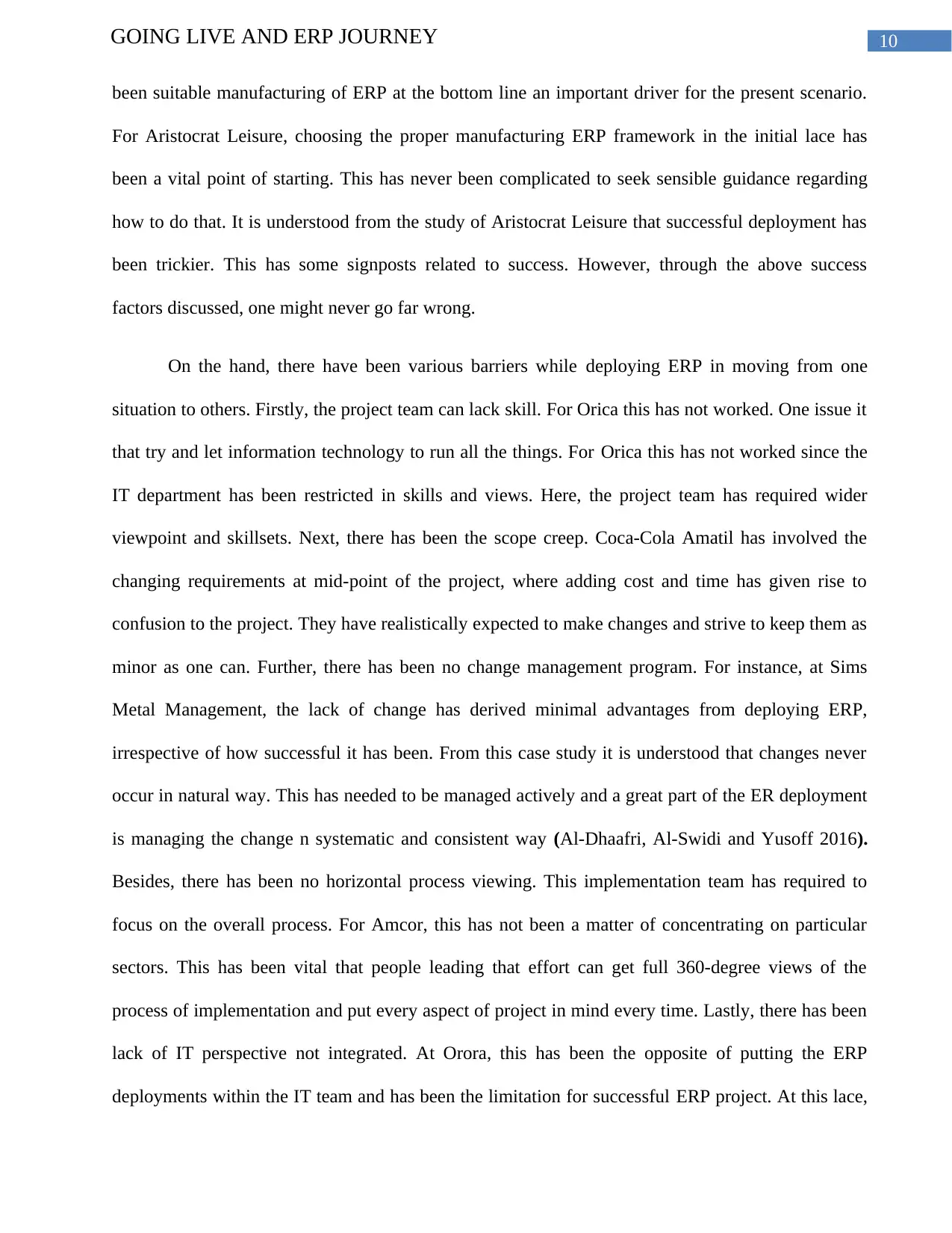
10GOING LIVE AND ERP JOURNEY
been suitable manufacturing of ERP at the bottom line an important driver for the present scenario.
For Aristocrat Leisure, choosing the proper manufacturing ERP framework in the initial lace has
been a vital point of starting. This has never been complicated to seek sensible guidance regarding
how to do that. It is understood from the study of Aristocrat Leisure that successful deployment has
been trickier. This has some signposts related to success. However, through the above success
factors discussed, one might never go far wrong.
On the hand, there have been various barriers while deploying ERP in moving from one
situation to others. Firstly, the project team can lack skill. For Orica this has not worked. One issue it
that try and let information technology to run all the things. For Orica this has not worked since the
IT department has been restricted in skills and views. Here, the project team has required wider
viewpoint and skillsets. Next, there has been the scope creep. Coca-Cola Amatil has involved the
changing requirements at mid-point of the project, where adding cost and time has given rise to
confusion to the project. They have realistically expected to make changes and strive to keep them as
minor as one can. Further, there has been no change management program. For instance, at Sims
Metal Management, the lack of change has derived minimal advantages from deploying ERP,
irrespective of how successful it has been. From this case study it is understood that changes never
occur in natural way. This has needed to be managed actively and a great part of the ER deployment
is managing the change n systematic and consistent way (Al-Dhaafri, Al-Swidi and Yusoff 2016).
Besides, there has been no horizontal process viewing. This implementation team has required to
focus on the overall process. For Amcor, this has not been a matter of concentrating on particular
sectors. This has been vital that people leading that effort can get full 360-degree views of the
process of implementation and put every aspect of project in mind every time. Lastly, there has been
lack of IT perspective not integrated. At Orora, this has been the opposite of putting the ERP
deployments within the IT team and has been the limitation for successful ERP project. At this lace,
been suitable manufacturing of ERP at the bottom line an important driver for the present scenario.
For Aristocrat Leisure, choosing the proper manufacturing ERP framework in the initial lace has
been a vital point of starting. This has never been complicated to seek sensible guidance regarding
how to do that. It is understood from the study of Aristocrat Leisure that successful deployment has
been trickier. This has some signposts related to success. However, through the above success
factors discussed, one might never go far wrong.
On the hand, there have been various barriers while deploying ERP in moving from one
situation to others. Firstly, the project team can lack skill. For Orica this has not worked. One issue it
that try and let information technology to run all the things. For Orica this has not worked since the
IT department has been restricted in skills and views. Here, the project team has required wider
viewpoint and skillsets. Next, there has been the scope creep. Coca-Cola Amatil has involved the
changing requirements at mid-point of the project, where adding cost and time has given rise to
confusion to the project. They have realistically expected to make changes and strive to keep them as
minor as one can. Further, there has been no change management program. For instance, at Sims
Metal Management, the lack of change has derived minimal advantages from deploying ERP,
irrespective of how successful it has been. From this case study it is understood that changes never
occur in natural way. This has needed to be managed actively and a great part of the ER deployment
is managing the change n systematic and consistent way (Al-Dhaafri, Al-Swidi and Yusoff 2016).
Besides, there has been no horizontal process viewing. This implementation team has required to
focus on the overall process. For Amcor, this has not been a matter of concentrating on particular
sectors. This has been vital that people leading that effort can get full 360-degree views of the
process of implementation and put every aspect of project in mind every time. Lastly, there has been
lack of IT perspective not integrated. At Orora, this has been the opposite of putting the ERP
deployments within the IT team and has been the limitation for successful ERP project. At this lace,
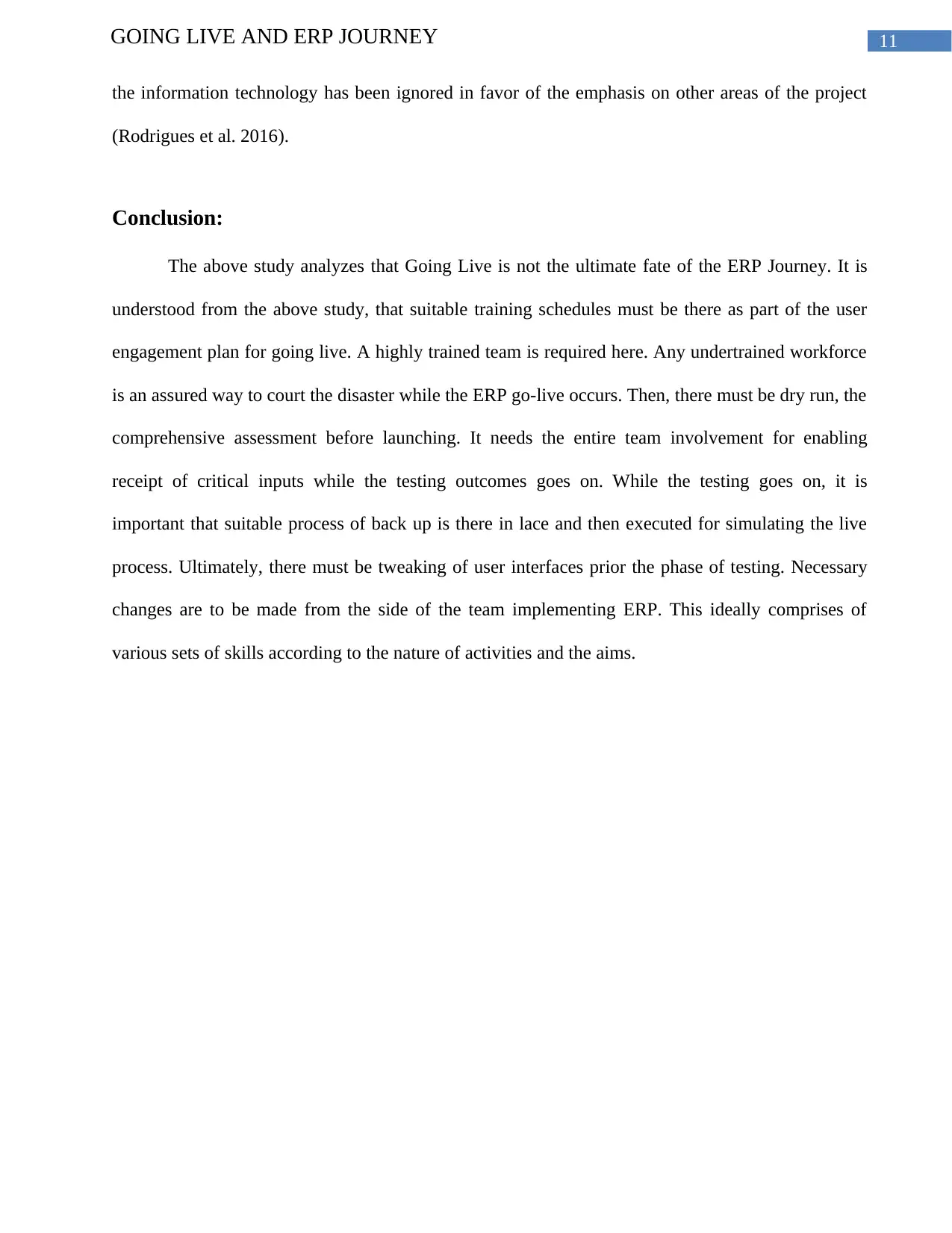
11GOING LIVE AND ERP JOURNEY
the information technology has been ignored in favor of the emphasis on other areas of the project
(Rodrigues et al. 2016).
Conclusion:
The above study analyzes that Going Live is not the ultimate fate of the ERP Journey. It is
understood from the above study, that suitable training schedules must be there as part of the user
engagement plan for going live. A highly trained team is required here. Any undertrained workforce
is an assured way to court the disaster while the ERP go-live occurs. Then, there must be dry run, the
comprehensive assessment before launching. It needs the entire team involvement for enabling
receipt of critical inputs while the testing outcomes goes on. While the testing goes on, it is
important that suitable process of back up is there in lace and then executed for simulating the live
process. Ultimately, there must be tweaking of user interfaces prior the phase of testing. Necessary
changes are to be made from the side of the team implementing ERP. This ideally comprises of
various sets of skills according to the nature of activities and the aims.
the information technology has been ignored in favor of the emphasis on other areas of the project
(Rodrigues et al. 2016).
Conclusion:
The above study analyzes that Going Live is not the ultimate fate of the ERP Journey. It is
understood from the above study, that suitable training schedules must be there as part of the user
engagement plan for going live. A highly trained team is required here. Any undertrained workforce
is an assured way to court the disaster while the ERP go-live occurs. Then, there must be dry run, the
comprehensive assessment before launching. It needs the entire team involvement for enabling
receipt of critical inputs while the testing outcomes goes on. While the testing goes on, it is
important that suitable process of back up is there in lace and then executed for simulating the live
process. Ultimately, there must be tweaking of user interfaces prior the phase of testing. Necessary
changes are to be made from the side of the team implementing ERP. This ideally comprises of
various sets of skills according to the nature of activities and the aims.
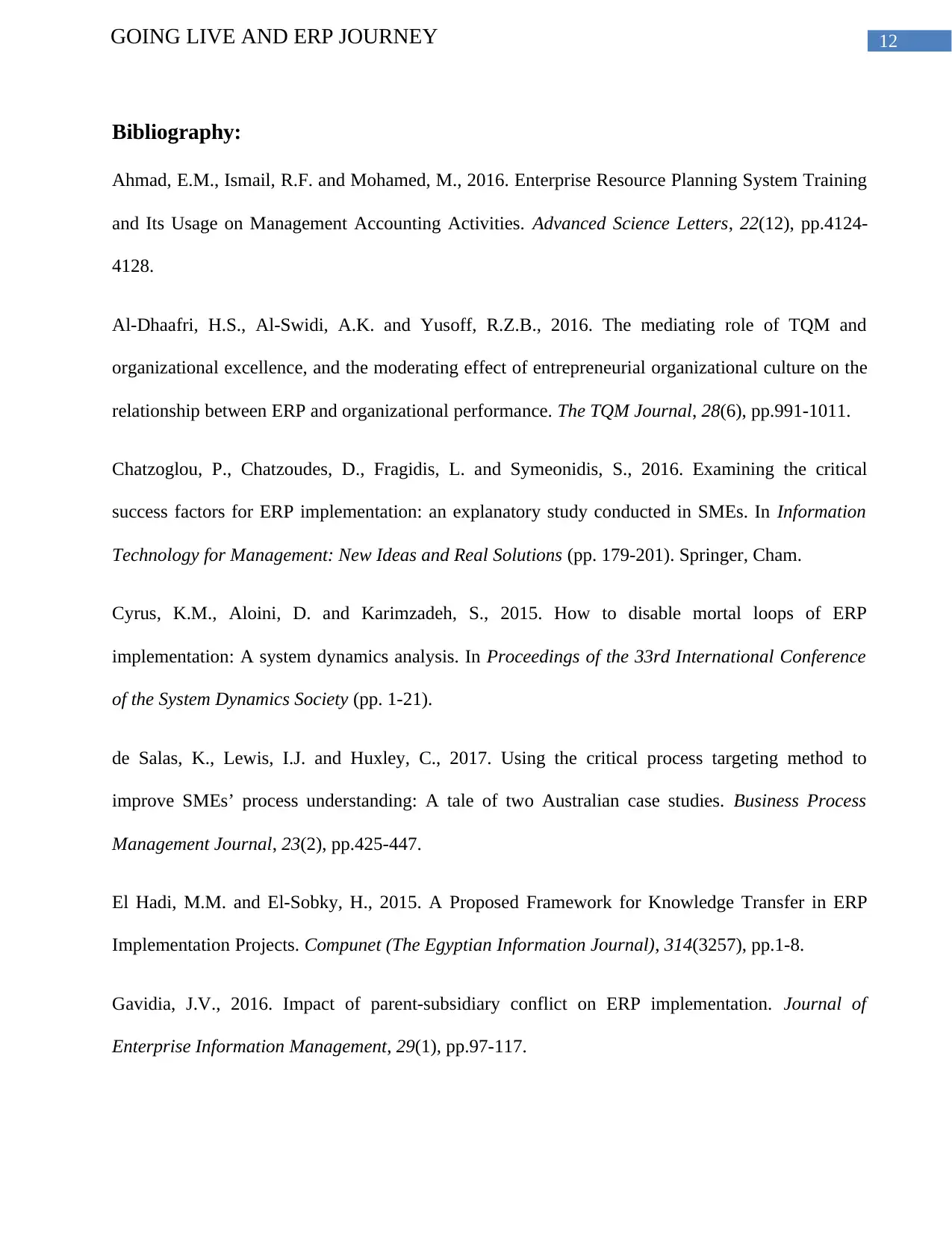
12GOING LIVE AND ERP JOURNEY
Bibliography:
Ahmad, E.M., Ismail, R.F. and Mohamed, M., 2016. Enterprise Resource Planning System Training
and Its Usage on Management Accounting Activities. Advanced Science Letters, 22(12), pp.4124-
4128.
Al-Dhaafri, H.S., Al-Swidi, A.K. and Yusoff, R.Z.B., 2016. The mediating role of TQM and
organizational excellence, and the moderating effect of entrepreneurial organizational culture on the
relationship between ERP and organizational performance. The TQM Journal, 28(6), pp.991-1011.
Chatzoglou, P., Chatzoudes, D., Fragidis, L. and Symeonidis, S., 2016. Examining the critical
success factors for ERP implementation: an explanatory study conducted in SMEs. In Information
Technology for Management: New Ideas and Real Solutions (pp. 179-201). Springer, Cham.
Cyrus, K.M., Aloini, D. and Karimzadeh, S., 2015. How to disable mortal loops of ERP
implementation: A system dynamics analysis. In Proceedings of the 33rd International Conference
of the System Dynamics Society (pp. 1-21).
de Salas, K., Lewis, I.J. and Huxley, C., 2017. Using the critical process targeting method to
improve SMEs’ process understanding: A tale of two Australian case studies. Business Process
Management Journal, 23(2), pp.425-447.
El Hadi, M.M. and El-Sobky, H., 2015. A Proposed Framework for Knowledge Transfer in ERP
Implementation Projects. Compunet (The Egyptian Information Journal), 314(3257), pp.1-8.
Gavidia, J.V., 2016. Impact of parent-subsidiary conflict on ERP implementation. Journal of
Enterprise Information Management, 29(1), pp.97-117.
Bibliography:
Ahmad, E.M., Ismail, R.F. and Mohamed, M., 2016. Enterprise Resource Planning System Training
and Its Usage on Management Accounting Activities. Advanced Science Letters, 22(12), pp.4124-
4128.
Al-Dhaafri, H.S., Al-Swidi, A.K. and Yusoff, R.Z.B., 2016. The mediating role of TQM and
organizational excellence, and the moderating effect of entrepreneurial organizational culture on the
relationship between ERP and organizational performance. The TQM Journal, 28(6), pp.991-1011.
Chatzoglou, P., Chatzoudes, D., Fragidis, L. and Symeonidis, S., 2016. Examining the critical
success factors for ERP implementation: an explanatory study conducted in SMEs. In Information
Technology for Management: New Ideas and Real Solutions (pp. 179-201). Springer, Cham.
Cyrus, K.M., Aloini, D. and Karimzadeh, S., 2015. How to disable mortal loops of ERP
implementation: A system dynamics analysis. In Proceedings of the 33rd International Conference
of the System Dynamics Society (pp. 1-21).
de Salas, K., Lewis, I.J. and Huxley, C., 2017. Using the critical process targeting method to
improve SMEs’ process understanding: A tale of two Australian case studies. Business Process
Management Journal, 23(2), pp.425-447.
El Hadi, M.M. and El-Sobky, H., 2015. A Proposed Framework for Knowledge Transfer in ERP
Implementation Projects. Compunet (The Egyptian Information Journal), 314(3257), pp.1-8.
Gavidia, J.V., 2016. Impact of parent-subsidiary conflict on ERP implementation. Journal of
Enterprise Information Management, 29(1), pp.97-117.
Paraphrase This Document
Need a fresh take? Get an instant paraphrase of this document with our AI Paraphraser
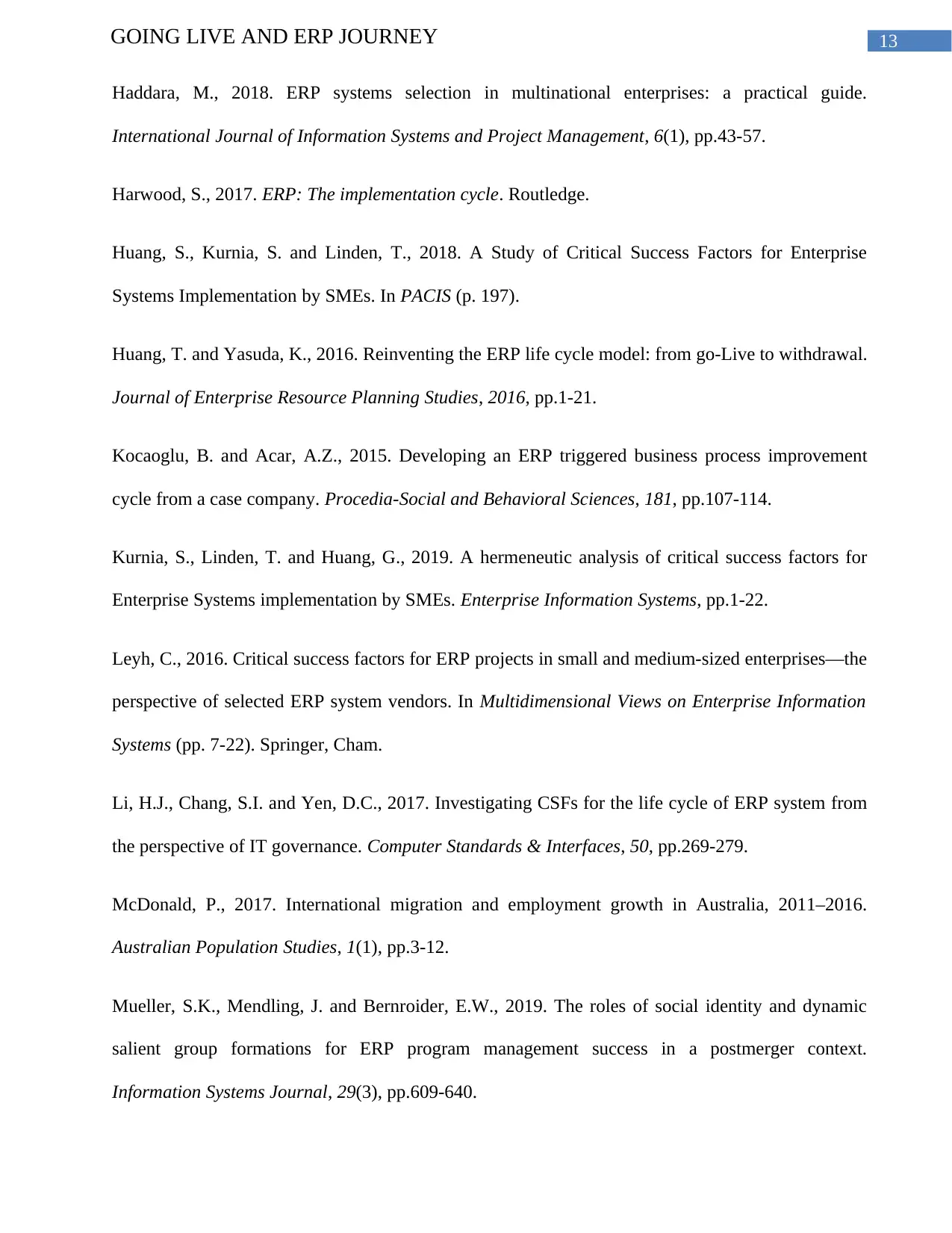
13GOING LIVE AND ERP JOURNEY
Haddara, M., 2018. ERP systems selection in multinational enterprises: a practical guide.
International Journal of Information Systems and Project Management, 6(1), pp.43-57.
Harwood, S., 2017. ERP: The implementation cycle. Routledge.
Huang, S., Kurnia, S. and Linden, T., 2018. A Study of Critical Success Factors for Enterprise
Systems Implementation by SMEs. In PACIS (p. 197).
Huang, T. and Yasuda, K., 2016. Reinventing the ERP life cycle model: from go-Live to withdrawal.
Journal of Enterprise Resource Planning Studies, 2016, pp.1-21.
Kocaoglu, B. and Acar, A.Z., 2015. Developing an ERP triggered business process improvement
cycle from a case company. Procedia-Social and Behavioral Sciences, 181, pp.107-114.
Kurnia, S., Linden, T. and Huang, G., 2019. A hermeneutic analysis of critical success factors for
Enterprise Systems implementation by SMEs. Enterprise Information Systems, pp.1-22.
Leyh, C., 2016. Critical success factors for ERP projects in small and medium-sized enterprises—the
perspective of selected ERP system vendors. In Multidimensional Views on Enterprise Information
Systems (pp. 7-22). Springer, Cham.
Li, H.J., Chang, S.I. and Yen, D.C., 2017. Investigating CSFs for the life cycle of ERP system from
the perspective of IT governance. Computer Standards & Interfaces, 50, pp.269-279.
McDonald, P., 2017. International migration and employment growth in Australia, 2011–2016.
Australian Population Studies, 1(1), pp.3-12.
Mueller, S.K., Mendling, J. and Bernroider, E.W., 2019. The roles of social identity and dynamic
salient group formations for ERP program management success in a postmerger context.
Information Systems Journal, 29(3), pp.609-640.
Haddara, M., 2018. ERP systems selection in multinational enterprises: a practical guide.
International Journal of Information Systems and Project Management, 6(1), pp.43-57.
Harwood, S., 2017. ERP: The implementation cycle. Routledge.
Huang, S., Kurnia, S. and Linden, T., 2018. A Study of Critical Success Factors for Enterprise
Systems Implementation by SMEs. In PACIS (p. 197).
Huang, T. and Yasuda, K., 2016. Reinventing the ERP life cycle model: from go-Live to withdrawal.
Journal of Enterprise Resource Planning Studies, 2016, pp.1-21.
Kocaoglu, B. and Acar, A.Z., 2015. Developing an ERP triggered business process improvement
cycle from a case company. Procedia-Social and Behavioral Sciences, 181, pp.107-114.
Kurnia, S., Linden, T. and Huang, G., 2019. A hermeneutic analysis of critical success factors for
Enterprise Systems implementation by SMEs. Enterprise Information Systems, pp.1-22.
Leyh, C., 2016. Critical success factors for ERP projects in small and medium-sized enterprises—the
perspective of selected ERP system vendors. In Multidimensional Views on Enterprise Information
Systems (pp. 7-22). Springer, Cham.
Li, H.J., Chang, S.I. and Yen, D.C., 2017. Investigating CSFs for the life cycle of ERP system from
the perspective of IT governance. Computer Standards & Interfaces, 50, pp.269-279.
McDonald, P., 2017. International migration and employment growth in Australia, 2011–2016.
Australian Population Studies, 1(1), pp.3-12.
Mueller, S.K., Mendling, J. and Bernroider, E.W., 2019. The roles of social identity and dynamic
salient group formations for ERP program management success in a postmerger context.
Information Systems Journal, 29(3), pp.609-640.
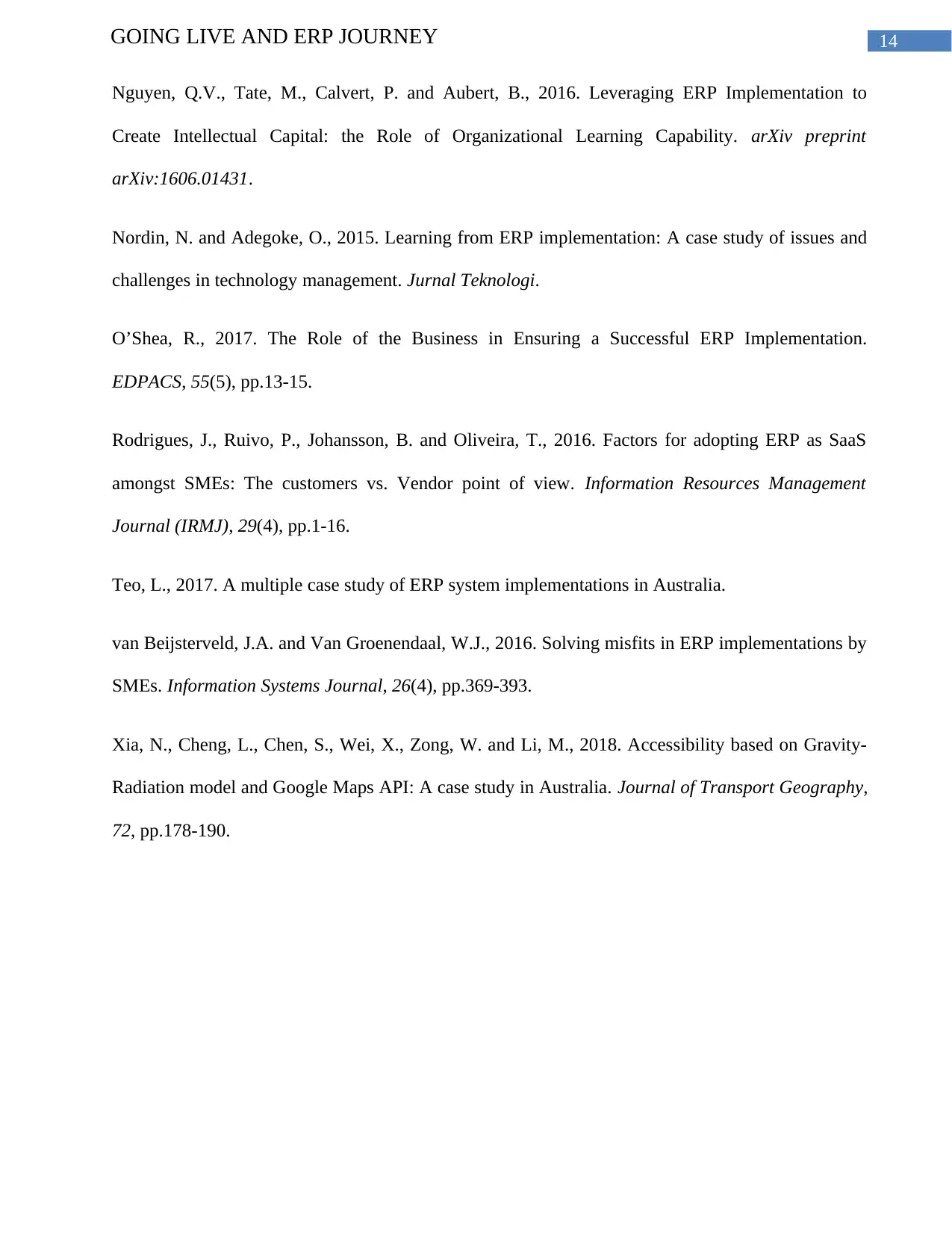
14GOING LIVE AND ERP JOURNEY
Nguyen, Q.V., Tate, M., Calvert, P. and Aubert, B., 2016. Leveraging ERP Implementation to
Create Intellectual Capital: the Role of Organizational Learning Capability. arXiv preprint
arXiv:1606.01431.
Nordin, N. and Adegoke, O., 2015. Learning from ERP implementation: A case study of issues and
challenges in technology management. Jurnal Teknologi.
O’Shea, R., 2017. The Role of the Business in Ensuring a Successful ERP Implementation.
EDPACS, 55(5), pp.13-15.
Rodrigues, J., Ruivo, P., Johansson, B. and Oliveira, T., 2016. Factors for adopting ERP as SaaS
amongst SMEs: The customers vs. Vendor point of view. Information Resources Management
Journal (IRMJ), 29(4), pp.1-16.
Teo, L., 2017. A multiple case study of ERP system implementations in Australia.
van Beijsterveld, J.A. and Van Groenendaal, W.J., 2016. Solving misfits in ERP implementations by
SMEs. Information Systems Journal, 26(4), pp.369-393.
Xia, N., Cheng, L., Chen, S., Wei, X., Zong, W. and Li, M., 2018. Accessibility based on Gravity-
Radiation model and Google Maps API: A case study in Australia. Journal of Transport Geography,
72, pp.178-190.
Nguyen, Q.V., Tate, M., Calvert, P. and Aubert, B., 2016. Leveraging ERP Implementation to
Create Intellectual Capital: the Role of Organizational Learning Capability. arXiv preprint
arXiv:1606.01431.
Nordin, N. and Adegoke, O., 2015. Learning from ERP implementation: A case study of issues and
challenges in technology management. Jurnal Teknologi.
O’Shea, R., 2017. The Role of the Business in Ensuring a Successful ERP Implementation.
EDPACS, 55(5), pp.13-15.
Rodrigues, J., Ruivo, P., Johansson, B. and Oliveira, T., 2016. Factors for adopting ERP as SaaS
amongst SMEs: The customers vs. Vendor point of view. Information Resources Management
Journal (IRMJ), 29(4), pp.1-16.
Teo, L., 2017. A multiple case study of ERP system implementations in Australia.
van Beijsterveld, J.A. and Van Groenendaal, W.J., 2016. Solving misfits in ERP implementations by
SMEs. Information Systems Journal, 26(4), pp.369-393.
Xia, N., Cheng, L., Chen, S., Wei, X., Zong, W. and Li, M., 2018. Accessibility based on Gravity-
Radiation model and Google Maps API: A case study in Australia. Journal of Transport Geography,
72, pp.178-190.
1 out of 15
Related Documents
Your All-in-One AI-Powered Toolkit for Academic Success.
+13062052269
info@desklib.com
Available 24*7 on WhatsApp / Email
![[object Object]](/_next/static/media/star-bottom.7253800d.svg)
Unlock your academic potential
© 2024 | Zucol Services PVT LTD | All rights reserved.



